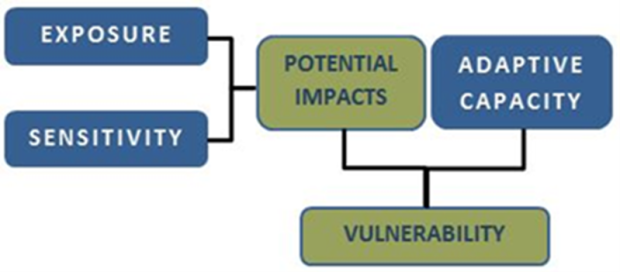How will climate change make things worse?
Climate change is expected to change rainfall patterns in ways that may increase pathogens in beach water and occurrences of CyanoHABs. Flooding can carry contaminated runoff and nutrients into waterbodies and increase the risk of exposure to pathogens and occurrence of CyanoHABs. Increases in water temperature will likely increase the growth and survivability of pathogens and the occurrence of CyanoHABs.
Who is exposed to contaminated recreational water?
People are exposed to pathogens and other harmful organisms by swimming in contaminated water. Most beach water pathogens come from human or animal waste, which may enter the water from storm water runoff, combined sewer overflows (a release of untreated sewage with rainwater), and poorly functioning septic systems. Cyanobacteria are naturally occurring but may become highly concentrated (i.e., bloom) under certain environmental conditions, particularly during hot weather, and may cause health effects via ingestion, skin contact, and inhalation of contaminated droplets.
What are the health effects?
Swimming in water contaminated with pathogens can cause gastrointestinal symptoms such as nausea, vomiting, diarrhea, and abdominal pain; respiratory symptoms like sore throat, cough, runny nose, and sneezing; eye and ear symptoms including irritation, earache, and itchiness; dermatological symptoms like skin rash and itching; and flu-like symptoms such as fever and chills. Most of these effects are self-resolving but they can occasionally be more serious, especially in sensitive populations (e.g. children, immunocompromised individuals, and older adults). Cyanobacteria produce toxins that can affect the skin, the liver, and the neurological system.
Who is vulnerable to waterborne illness?
Identifying populations most vulnerable to the health burdens of climate change is an important step in developing state and local adaptation plans. Publicly available data can be used to assess the health-related vulnerability for waterborne illness at recreational beaches. Some examples of vulnerability data for Massachusetts are provided below.
- Massachusetts beaches are closed hundreds of times each year due to poor water quality (exceeding bacteria standards)1
- Massachusetts has 1,100 fresh water and marine beaches in 220 communities1
- 5.3% of MA residents are under age 52
- 14.7% of MA residents are age 65 or older2
How can we assess vulnerability to climate hazards?
Climate vulnerability is a function of:
- Potential impacts from exposure (contact with the climate hazard) and sensitivity (e.g., age, pre-existing health conditions, social disparities) that may increase or decrease health impacts
- Adaptive capacity – factors that influence the ability to respond and recover from climate impacts
This page provides information to assess exposure, sensitivity, and adaptive capacity to reduce climate change impacts. This information should be considered when planning actions to reduce health risks from waterborne illness at recreational beaches in Massachusetts communities.
What are the factors that influence vulnerability to recreational waterborne illness?
Assessment of community-specific vulnerabilities will inform adaptation planning efforts. By considering these factors, communities can increase health equity and resilience to climate change impacts. The Massachusetts Environmental Public Health Tracking website provides helpful tools and community-specific vulnerability data.
- Sociodemographic
- People over age 65
- Children under age 5
- Environmental
- Beaches with a history of elevated bacteria levels or CyanoHABs
- Beaches near densely populated areas
- Beaches impacted by improper pet waste disposal or nutrient runoff
- Pre-Existing Health Conditions
- People with suppressed immune systems
- Pregnant women
- Infrastructure
- Large areas of landscaped land and/or impervious surfaces near waterways
- Septic systems, sewer overflows, and storm water outfall pipes near waterbodies
- Areas where flooding is frequent
Intervention Strategies for Reducing the Health Impacts of Waterborne Illness
- Explore current and historical beach water quality test results on the DPH Recreational Water Quality webpage
- Identify vulnerable populations and health issues in your community using the DPH Community Profiles, and other tools available on the EPHT website
- Install pet waste bag dispensers and trash receptacles to reduce trash and pet waste near waterbodies
- Organize community-wide clean-up days
- Develop education materials for homeowners and businesses around the proper use of fertilizers
- Examine potential impacts of rainfall on beach water quality by reviewing historical testing data and rainfall information
- Develop an Adopt-a-Traffic-Island Program that incorporates green practices, such as water retention and low maintenance plantings
- Develop a community storm water management program that includes such activities as illicit discharge detection, construction site runoff control, and street sweeping
- Reduce the quantity of impervious surfaces by incorporating green infrastructure into residential and commercial developments
- Relocate problematic pollutant sources away from flood plains
- Modify and enforce watershed protection regulations to take climate change into account
- Evaluate and prioritize implementation of improved controls of agricultural, urban, and storm water runoff to prevent ocean and freshwater contamination, as well as the inadvertent enrichment of nutrients in aquatic areas that offer ideal growth medium for harmful algal blooms
- View the 2023 ResilientMass Plan for information on adaptation strategies
- View the Massachusetts Climate Change Adaptation Report, Chapter 6: “Human Health and Welfare” for health adaptation strategies
References
- 2019 Massachusetts Beach Testing Results Annual Report
- 5-Year US Census American Cities Survey, 2018. For data, visit MassMapper.
Who can I contact to learn more?
Specialists at the Massachusetts Department of Public Health, Bureau of Climate and Environmental Health, are available to answer your questions. Contact us at 617-624-5757 (TTY: 617-624-5286).
Additional Resources
-
Open PDF file, 324.96 KB, Climate Hazard Assessment Profile: Recreational Water Quality (English, PDF 324.96 KB)
-
Open DOCX file, 1.39 MB, Climate Hazard Assessment Profile: Recreational Water Quality (English, DOCX 1.39 MB)
